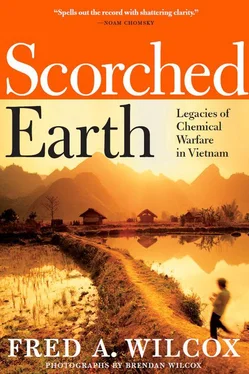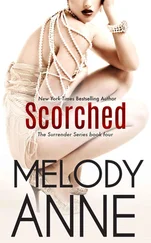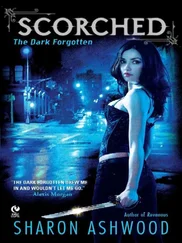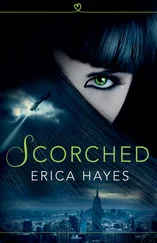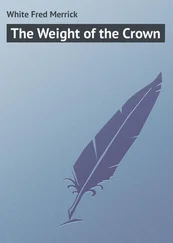Testifying before a US Senate Committee on Veterans’ Affairs, Maureen Ryan, whose husband served with the Marines in Vietnam, and whose daughter was born with at least sixteen birth defects, lamented the toll the war had taken on veterans’ offspring.
“Just as truly as the bullets and bombs killed on the battlefields in Vietnam,” said Mrs. Ryan, “maiming thousands of our men, Agent Orange has come home from those battlefields with our men. It has come home to maim and kill additional thousands of men who naively thought they had made it home safely. It would be tragic enough if it had ended there.
“But what the United States and what our Vietnam veterans did not know was that they carried home a tremendous legacy with them. They did not know that their children were with them on the battlefield, genetically. So Agent Orange is now reaping an additional harvest of birth defects and cancers in our children and men. We are losing our children through spontaneous abortions, through miscarriages, and perhaps most tragically in the surviving children, with the horrifying birth defects.” 7
Angered by the Veterans Administration’s argument that it had not conducted an Agent Orange outreach program because it did not wish to confuse or frighten veterans and their wives, Ryan said, “It is not frightening when you are handed knowledge. It is much more frightening when you are kept in the dark. It is much more frightening to give birth to a child with birth defects. It is more frightening to know your husband is dying of cancer.” 8
In July 2009, the Bookworm bookstore in Hanoi invited me to give a public talk, at which I was asked what I thought about conducting more research studies on the effects of Agent Orange/dioxin on human beings. I answered that before we do any more studies we should find ways to help victims of the defoliation campaign. This upset one woman who argued that scientists need to crunch more numbers, juggle more statistics, and collect more evidence. But how long will it take to secure funding for these studies? And once this research is complete, exactly how many more years will it take for a panel to peer review the methodology and findings of a particular study? Once a study is deemed credible, how long will it be before scientists working for the chemical companies attempt to discredit the researchers’ findings? After five, ten, fifteen years, will the original study be tossed out or repeated, using altogether new methods for determining correlations between dioxin exposure and birth defects, cancer, and a host of other illnesses?
Meanwhile, the twisted body of a thirty-one-year-old man lies upon a bamboo pallet in Cu Chi district. His mother feeds him, changes his clothing, and massages his limbs to soothe the discomfort and pain he cannot describe. Are there one, two, five million victims of chemical welfare? Do the numbers matter? By the time more studies on the effects of Agent Orange/dioxin on human beings are completed, many more Vietnamese children will have died, leaving their parents to grieve and to wonder what their lives might have been like if their country had been allowed to live in peace.
CHAPTER 11
Chemical Children
These Agent Orange births are normal for us…. Every now and then we have what we call a fetal catastrophe—when the number of miscarriages and deformed babies, I am afraid to say, overwhelms us.
—Dr. Pham Viet Than, Tu Du Hospital
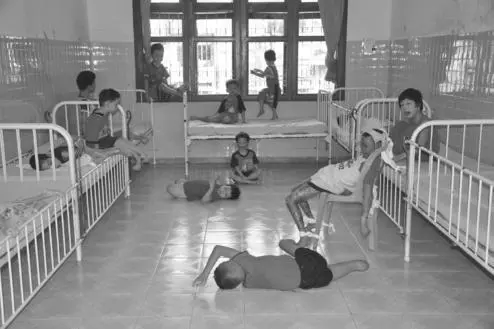
Agent Orange children in Tu Du Hospital.
To visitors, the quiet unassuming demeanor of Vietnamese people might be disconcerting. Given the costs of the war—between two and five million Vietnamese dead, several million victims of Agent Orange, including more than 150,000 children, hundreds of thousands of missing soldiers, broken promises, a prolonged and punishing trade embargo—one might expect anger, accusations, perhaps even insults. On the contrary, US veterans who return to the sites where they once fought vicious battles meet former enemies who welcome them as friends. The warriors get drunk together, sing, tell stories, and do what they can to heal the wounds of a long cruel war.
In the visitors’ room at Tu Du, there’s a display of books and pamphlets on Agent Orange, one with the peculiar title, “Cheer Up, Viet and Duc!” Inside of this book, there’s a black and white photograph of Siamese twin boys connected at the waist, with one pair of legs and one set of genitals protruding from the point where the babies are attached. The twins, Viet and Duc, were born on February 25, 1981, in the Gialai-Kontum area in the Central Highlands, a heavily defoliated region of Vietnam. Terrified that they had given birth to “monsters,” the boy’s parents abandoned them, and the twins were flown to the Vietnam-East German Friendship Hospital, but they were quite ill and could not be separated. When they were twelve months old, they were taken to Tu Du Hospital in Ho Chi Minh City.
“The Tu Du Maternity Hospital,” opens the book,
stands in a beautiful place in Ho Chi Minh City, where red and white tropical flowers and blossoms bloom all the year round.
Inside the hospital, about eight hundred women are suffering, mostly from cancer, and every two days one deformed baby is born. This problem was probably caused by the herbicide containing dioxin, which the US used in the Vietnam War.
Since the US began to use this poison in 1961, more than twenty conjoined babies have been born in Vietnam, but most of them either were born dead or died within one year. Only Viet and Duc have barely survived….
When I returned to my hotel and showed another Japanese a picture of Viet and Duc, he said very disgustedly, “Oh my goodness, why are such children kept alive?” I trembled with uncontrollable anger. Each and every human being has the right to live and develop.
The author decided to build a wheelchair for Viet and Duc, whom he describes as rather ordinary boys, in spite of the fact that they had the same organs in common, had to cooperate when urinating and excreting, and acknowledged that “it was certain that one’s illness could be a great threat to the other’s life.”
Lying unstably, Viet and Duc made fun of each other. Viet was very playful and fond of fruit. Duc liked learning and had a sweet tooth. They both loved cars. Duc was physically weaker and usually lay down while Viet sat up. So Duc’s side hair was worn out. 1
When I attempt to return the book to the display case, Dr. Nguyen Thi Phuong Tan, director of rehabilitation of the Hoa Binh Village at Tu Du Hospital, politely insists that I must carry it home. But this book is a rare find, most likely out of print, the hospital’s only copy. Dr. Tan smiles, her cell phone rings, I continue reading.
On October 4, 1988, a team of Japanese and Vietnamese doctors operated for fifteen hours at Tu Du Hospital to separate Viet and Duc. Viet survived twenty more years while Nguyen Duc still lives at the hospital.
Dr. Tan has been working in Tu Du hospital for twenty years, and she’s been in charge of this “Peace Village” for twelve years. There are sixty children here, many with disabilities like missing fingers and toes, mental disabilities, and some with dysfunctions of the spinal cord. Dr. Tan explains that other children suffer from some dysfunction or unusual alteration in their DNA. Most of the children come from Quang Tri Province, the Central Highlands, Kontum, and other defoliated regions.
Dr. Tan thinks that some of the boys and girls in Peace Villages like Hoa Binh are third generation Agent Orange children. Some of them need operations to repair their deformed faces so they can work outside of the village. Those who are capable of learning attend classes in the hospital. If the children’s parents fought in heavily sprayed areas, or if they were farmers there during the war, it’s reasonable to assume, says Dr. Tan, that they were exposed to dioxin.
Читать дальше
